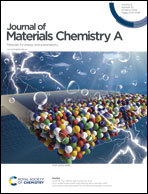Redox-driven confinement of quinone with imidazole in sub-nanometer sized porous carbon space mitigating chemical degradation for aqueous energy storage†
Abstract
Nanoconfinement of redox molecules influences their molecular interactions and leads to stabilization of a metastable form by alternation of their chemical reactivity, which is not observed in the bulk. Herein, we show that hydro- and benzoquinone can be (electro)chemically confined with imidazole in subnanometer-sized carbon pore regimes, and their chemical degradation induced by nucleophilic attacks was significantly mitigated. On the other hand, the formation of a quinone–imidazole complex became evident in a bulk solution phase containing both benzoquinone and imidazole. Molecular dynamics simulations and density functional theory calculation results clearly elucidated the stabilization of both hydro- and benzoquinone in a sub-nanometer sized carbon space due to their strong interactions with a carbon surface, which was thermodynamically more preferred than the formation of a quinone–imidazole complex. We further experimentally found that imidazole played a central role in stabilizing both hydro- and benzoquinone inside the restrained carbon pore regime. The charge–discharge characteristics associated with redox reactions by confined hydro- and benzoquinone in a microporous carbon regime were investigated and showed an ∼97% capacity retention rate over the 100th cycle. The enhanced electrode kinetics of the confined quinone redox reaction on a mesoporous carbon electrode was also discussed. This study demonstrated that the physicochemical nature of hydro- and benzoquinone can be altered by their (electro)chemical confinement with imidazole in a subnanometer-sized carbon regime, and their resilience against the nucleophilic attack could impact the development of various quinone-based aqueous energy storage systems for long term cyclability.



 Please wait while we load your content...
Please wait while we load your content...